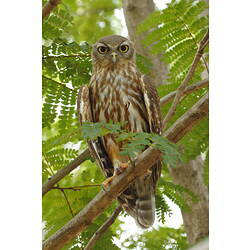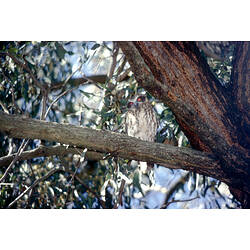General Description
Robust, medium-sized owl with a rufous-brown streaked pale front. Wings and back also rufous-brown with white spots. In eastern and southern Australia, areas of rufous-brown are greyish-brown. Large brown eyes with no distinct facial disc. White eyebrows. Strong yellow talons (claws). Males are up to 44 cm in height, while females are smaller to about 39 cm. Call a dog like "woof woof".
Biology
A nocturnal bird best known for its dog like "woof woof" call. In the evening it often performs in duet with a nearby partner. In southern areas they are known to give a long sobbing scream during the winter breeding season. They normally hunt at night in open areas for small to medium-sized mammals, reptiles, birds and insects. Mostly rests in the outer dense foliage of trees during the days, occasionally coming out late afternoon. They form permanent mating pairs often returning year after year to the same hollow to nest. They lay 2-3 dull white round eggs at the bottom of a tree hollow. In southern Australia their numbers have declined dramatically mostly due to habitat loss and degradation and competition from honey bees for tree hollows. However they remain relatively common in north Australia.
Distribution
Across Australia.
Habitat
Forest and woodland; however mostly absent from arid regions.
More Information
-
Animal Type
-
Animal SubType
-
Brief Id
Medium-sized robust brownish owl with a streaked pale front, most commonly identified by its dog-like "woof, woof" call.
-
Colours
Brown, Red, White
-
Maximum Size
44 cm
-
Habitats
-
Diet
Carnivore
-
Diet Categories
small vertebrates, Insects
-
Endemicity
-
Commercial
No
-
Conservation Statuses
CITES: Trade restrictions (Appendix II), FFG Threatened List: Critically Endangered, EPBC Act 1999: Not listed, IUCN Red List: Least Concern
-
Taxon Name
-
Common Name
Barking Owl
-
Other Names
Winking Owl
-
Kingdom
-
Phylum
-
Subphylum
-
Class
-
Order
-
Family
-
Genus
-
Species Name
connivens


